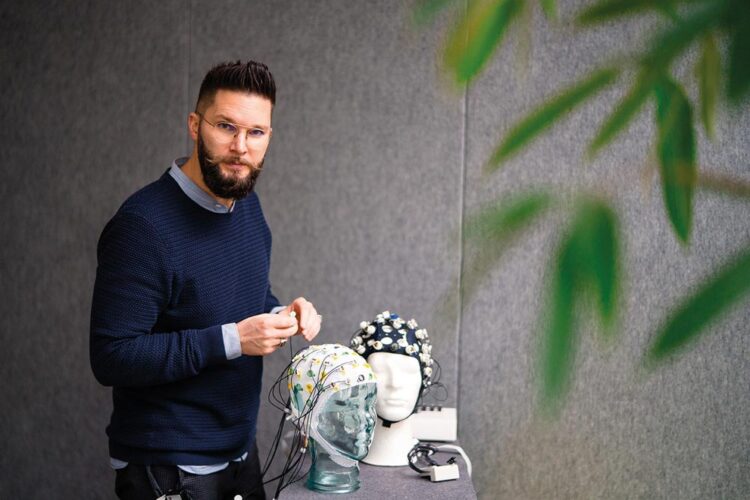The NeuroLab is a test environment for neuroergonomic questions that was opened at Fraunhofer IAO seven years ago. Since October 2021, Dr. Mathias Vukelic (see the box “Researcher profile – Mathias Vukelic”) has headed up the Applied Neurocognitive Systems research group there. Together with his colleagues, the neural- and behavioral scientist combines knowledge and methods from cognitive neuroscience and positive psychology with machine learning to create intelligent and adaptive technologies that foster subjective well-being including needs and invidual skills at work and in every day life. “Technology must be based on the individual’s needs and abilities; it should be assistance-based. We always put people at the center of our projects. With that in mind, we are committed to shaping a better future using smart technology. Technology should not be a burden or a nuisance to people; ideally, it should help them make better decisions and offer them the opportunity for personal development,” says the researcher, explaining the team’s vision. A main research topic of the team is neuroadaptive technologies – adaptable technical systems that detect users’ mental states using neurophysiological sensors (measuring cerebral and vital parameters), interpret these signals through signal processing and machine learning, and are then able to respond intelligently to the detected states of the users (adaptations of system behavior). “We want to enhance engineering disciplines by solving technical problems with neuroscientific and psychological expertise.”
Sensitive technology
The first step in this direction is to gain a better understanding of the cognitive processes and affective responses in different scenarios. To this end, the researchers measure parameters in human-machine interactions, such as the stress level, attention or even the cognitive load of humans, in order to be able to infer cognitive processes and emotional experiences from the measured cerebral and physiological reactions and thus develop systems that that leverage the full range of human potential to foster subjective well-being, thus creating a sustainable working day. “We can measure brain signals using neurophysiological measurement methods such as electroencephalography. These neurophysiological signals provide information about mental stress, attention performance and concentration, and even emotional responses while using technology or during training and learning processes. Using a sophisticated combination of signal processing and advanced machine learning methods, we can extract and interpret this information from the signals – for instance, whether a person is currently feeling overwhelmed or if they are motivated by learning success. AI and signal processing are therefore major areas of focus in our research work,” explains the expert.
At present, the experiments involving test subjects are still taking place in the controlled laboratory environment with extensive measurement methods and sensors (see the box “NeuroLab facilities and equipment”). Vukelic and his team are currently devising new experiments that will allow them to leave the low-stimulus environment and establish realistic scenarios.
Promoting professional inclusion with the use of virtual reality
The team is currently involved in the UFO project, which is funded by the German Federal Ministry of Education and Research (BMBF). In this project, virtual reality (VR) is used to help autistic people with professional inclusion. Autistic people have difficulty understanding their own feelings as well as those of others, and deciphering emotions.
Vukelic and his team are working to help autistic people understand emotions in a roundabout way. Heart and brain activity, respiration and other physiological processes that take place in connection with emotions are measured and made perceptible through tactile pulses emitted by a special wristband. The idea is that people with these special needs could learn the tactile patterns produced by the wristband, thereby enabling them to tap into their own feelings. This can be trained in a virtual learning and experience space, but the technology can also be applied in reality. “The next step is to make it possible to experience the emotions of our fellow human beings in this way,” says Vukelic.
Neuroscientific and psychological methods for healthier working environments
The researcher and his team also want to share their new approaches to neuroscience, psychology, data science and machine learning with companies and inform them about how mental health and well-being can be embedded more sustainably through technology. The event “Sustainable Work and Life” will present neuroscientific and psychological methods, customizable digital technology approaches and new forms of data processing to provide impetus for change. The event will take place at the Fraunhofer Institute for Industrial Engineering IAO on November 9, 2022. See the website below for a link.







